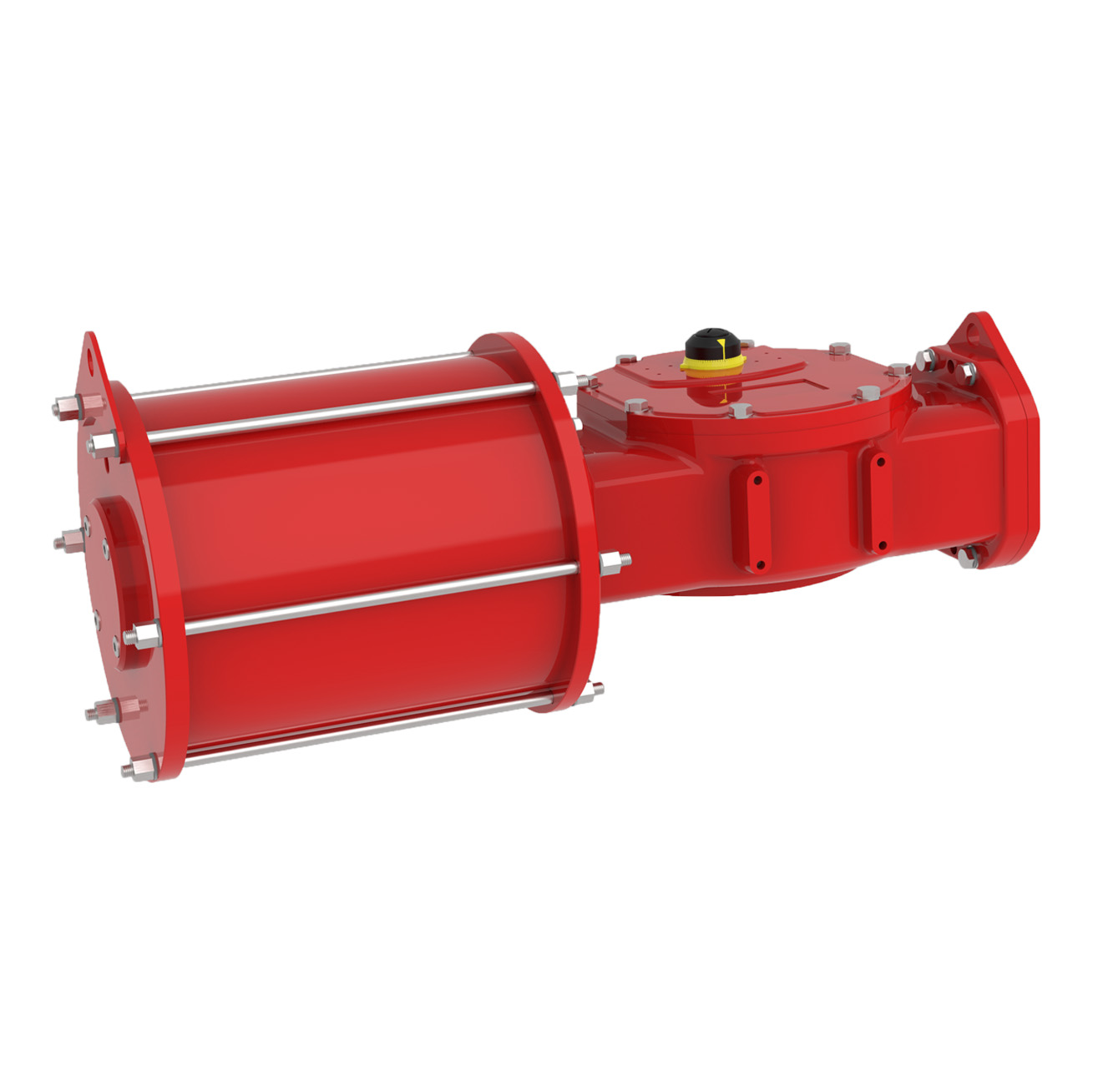What Makes the Scotch Yoke Pneumatic Actuator a High-Performance Choice?
2025-11-20
A Scotch Yoke Pneumatic Actuator is a mechanical device designed to convert linear pneumatic force into precise rotary motion, delivering high torque output with exceptional consistency. Its distinctive yoke mechanism allows the actuator to generate significantly higher torque at both the beginning and end of stroke, making it suitable for demanding valve automation tasks across oil and gas, chemical processing, power generation, water treatment, and various high-cycle industrial systems.
The focus centers on practical engineering benefits, long-cycle reliability, torque accuracy, and operational safety. Additionally, product parameters are presented clearly to support technical comparison and decision-making.
Product Parameters of Scotch Yoke Pneumatic Actuator
| Parameter Category | Specification Details |
|---|---|
| Actuator Type | Scotch Yoke Pneumatic Actuator |
| Rotation Angle | 90° (standard), optional 120° / 180° |
| Torque Output Range | 50 Nm – 250,000 Nm |
| Pressure Range | 2.5 bar – 8.0 bar |
| Operating Medium | Clean, dry compressed air or inert gas |
| Temperature Range | -20°C to +80°C (standard), optional low-temperature and high-temperature configurations |
| Valve Compatibility | Ball valves, butterfly valves, plug valves, damper valves |
| Yoke Mechanism | Symmetric or canted Scotch yoke torque profile |
| Material | Carbon steel / ductile iron / aluminum alloy body |
| Surface Treatment | Hard anodizing, epoxy coating, corrosion-resistant paint |
| Mounting Interface | ISO 5211 compatible |
| Control Options | On-off, modulating control, fail-safe configuration |
| Accessories | Limit switches, solenoid valves, positioners, air filter regulators |
This parameter list allows users and engineers to rapidly identify the suitability of the Scotch Yoke Pneumatic Actuator for high-torque, high-frequency valve control applications.
Why Do Industrial Systems Prefer the Scotch Yoke Pneumatic Actuator?
Selecting the right actuator directly affects operational safety, energy consumption, maintenance intervals, and valve performance. The Scotch yoke design is favored because it provides a torque profile that aligns naturally with the torque demands of quarter-turn valves. This section explains the key reasons behind its industry-wide adoption.
Why Does the Torque Curve Offer a Practical Advantage?
Quarter-turn valves typically require high break-torque to move from the closed position. The Scotch yoke mechanism delivers peak torque at this exact point, enabling rapid and safe valve opening without oversizing the actuator. After the valve begins to move, required torque decreases, aligning perfectly with the actuator’s torque distribution.
Why Does the Mechanical Structure Increase Reliability?
The actuator’s internal architecture features fewer sliding components than rack-and-pinion actuators. By using a robust yoke slot and a piston rod, the system experiences reduced wear, lower friction, and longer operational life. This directly benefits industries where downtime leads to high financial impact.
Why Is It Suitable for Harsh or Corrosive Environments?
Corrosion-resistant surface treatments and optional stainless-steel components allow the actuator to operate in saltwater environments, chemical plants, and offshore platforms. High-grade seals maintain airtight performance even under fluctuating temperatures and humidity.
Why Is Its Energy Efficiency Notable?
The actuator uses compressed air more effectively, generating higher torque with the same air volume, reducing energy demand for compressors. Over long operational cycles, this efficiency results in cost savings and reduced carbon footprint.
Why Do Operators Prefer Its Consistent Output?
The Scotch yoke design minimizes torque ripple during operation, producing smoother rotation. This leads to reduced vibration, extended valve lifespan, and stable process control—especially important in modulating applications where precision is essential.
How Does the Scotch Yoke Pneumatic Actuator Operate and Deliver Functional Advantages?
Understanding how the actuator works provides insight into its functional value, efficiency, and operational stability. The actuator translates pneumatic pressure into linear piston motion, and the piston drives a sliding yoke that converts linear movement into rotation.
How Does the Conversion Mechanism Work?
-
Compressed air enters the cylinder chamber.
-
The piston moves linearly due to air pressure.
-
The piston rod transfers the force into the yoke slot.
-
The yoke rotates around its shaft, converting linear travel into a 90° or 180° rotation.
-
The valve mounted on the output shaft rotates accordingly to open or close the flow path.
How Does the Actuator Maintain Control Accuracy?
The geometry of the yoke slot defines the torque curve, ensuring predictable movement. When paired with feedback devices such as positioners and limit switches, the actuator maintains precise valve positioning even in dynamic control loops.
How Does the Design Reduce Maintenance Needs?
-
Fewer meshing gears
-
Reduced friction surfaces
-
Optimized air consumption
-
Durable bushings and bearings
-
Easy access to internal components
This results in lower inspection frequency and simplified replacement procedures.
How Does It Improve Operational Safety?
Fail-safe configurations allow the valve to return to a predetermined position (open or closed) during power loss or air-supply interruption. This protects pipelines, equipment, and personnel in critical industries.
How Does It Support Customization for Different Industries?
The actuator can be manufactured with different torque profiles, materials, coatings, and stroke options. This flexibility accommodates:
-
Offshore oil extraction
-
LNG processing
-
Petrochemical plants
-
Power plants
-
Wastewater treatment facilities
-
Pulp and paper manufacturing
Different industries benefit from targeted performance characteristics tailored to their operational loads.
What Future Trends Are Shaping the Scotch Yoke Pneumatic Actuator Industry?
Industrial automation continues to evolve toward higher efficiency, stronger environmental resistance, and smarter data-driven control. The Scotch Yoke Pneumatic Actuator aligns with these trends while maintaining mechanical reliability.
Trend 1: Integration With Smart Valve Control Systems
Next-generation systems are incorporating digital positioners, real-time monitoring, and torque feedback sensors. These improvements allow predictive maintenance, reducing downtime and optimizing asset management.
Trend 2: Increased Demand for High-Torque Efficiency
As pipelines and industrial valves grow in size and pressure rating, the demand for actuators with stronger starting torque continues climbing. The actuator’s torque profile makes it ideal for this upscaling trend.
Trend 3: Enhanced Surface Protection
Advanced anti-corrosion coatings and composite materials will extend service life in offshore and chemical industries where equipment faces extreme exposure.
Trend 4: Energy-Conscious Pneumatic Systems
Industries are increasingly adopting pneumatic systems with lower air consumption. The Scotch yoke mechanism is being optimized for improved airflow efficiency, reducing long-term operational expenditure.
Trend 5: Modular Design for Faster Configuration
Modular accessory systems—positioners, limit switches, solenoid valves, and filter regulators—are becoming easier to integrate. This simplifies installation and accelerates system commissioning.
Common FAQs About Scotch Yoke Pneumatic Actuators
Q1: What type of valves are best suited for Scotch Yoke Pneumatic Actuators?
A1: These actuators are ideal for quarter-turn valves such as ball valves, butterfly valves, plug valves, and certain damper systems. They provide high break-torque that aligns with the torque demands of valves experiencing static friction at the start of movement. Their precision and stable torque curve also make them suitable for modulating applications requiring accurate positioning.
Q2: How long is the typical service life of a Scotch Yoke Pneumatic Actuator?
A2: Service life depends on factors such as air quality, lubrication, environmental exposure, and cycle frequency. However, the actuator’s strong mechanical structure, minimal gear components, and highly durable seals allow service life ranging from hundreds of thousands to several million cycles. When combined with proper filtration and preventive maintenance, the actuator can achieve long-term reliable operation even in harsh conditions.
Q3: How should an industrial facility select the correct actuator size?
A3: Sizing should consider the valve’s required break-torque, running torque, shutoff torque, operating pressure, safety margin, and environmental factors such as temperature and corrosion exposure. Engineers commonly evaluate torque charts provided by manufacturers to match actuator output with valve torque requirements. Undersizing and oversizing should be avoided to ensure optimal performance and energy usage.
How Does the Scotch Yoke Pneumatic Actuator Continue Delivering Value in Modern Automation?
The Scotch Yoke Pneumatic Actuator stands out as a powerful, efficient, and reliable solution for industries requiring precise rotary motion control and high output torque. Its mechanical advantage, customization options, long-term durability, and compatibility with advanced control technologies make it a strong choice for current and future industrial automation systems. As industries continue advancing toward smarter, more efficient, and environmentally robust operation, the actuator’s design will remain highly relevant and widely adopted.
In the development and manufacturing of high-quality Scotch yoke pneumatic actuators, Juhang Automation Equipment Technology Co., Ltd. provides professional solutions, precise engineering standards, and long-term reliability for global industrial applications. For detailed specifications, project consultations, or customized actuator solutions, Contact Us to receive professional assistance tailored to your operational needs.



